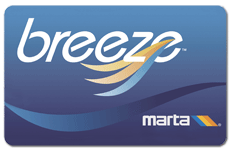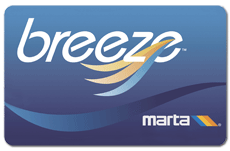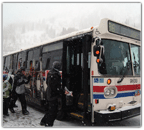Atlanta’s transit authority, MARTA, is taking the Georgia city contactless
01 February, 2003
category: Contactless, Library, Transit
BY KIMBERLY BRENNER
CONTRIBUTING EDITOR
Atlanta Georgia, known for the Braves, Coca-Cola, and CNN, is one of the fastest growing cities in the United States. It is also home to the ninth largest transit system in the U.S. The Metropolitan Atlanta Rapid Transit Authority (MARTA) provides bus, rail, and paratransit service for 550,000 residents and visitors each day. According to the Atlanta Regional Commission (ARC), the primary cause of Atlanta’s growth is its strategic location in the air, rail and highway networks of the southeastern United States. It is vital that these transportation networks keep the pace with the latest technology. To this end, MARTA has plans to convert the current token and magnetic stripe-based fare collection systems into a contactless card-based system.
MARTA is currently evaluating proposals for the smart card system and is in the “Best and Final Offer” stage of the procurement process. The RFP for replacement of the Authority’s rail fare gates, bus fare boxes, vending machines and the associated data systems was issued in January of 2002 and The Authority began reviewing the proposals in August of that year. MARTA hopes to make a recommendation to the Board during the summer of 2003.
The current schedule is to enter the design and manufacture phase immediately following the awarded contract. Installation of equipment is to begin in mid-2004 and installation should be complete during mid 2005. MARTA’s Program Manager, Neil Poling said, “Our system is to be an integrated bus, rail and parking fare collection system. Our objectives are to provide our Board of Directors with a full range of fare options (including flat fare, zone fares, distance fares, off-peak fares and more); and to build a regional seamless system in cooperation with our regional transportation partners.”
When asked why the Authority elected to pursue contactless technology, Mr. Poling replied that they are seeking “to improve customer service, lower maintenance costs, enhance ridership information and engage private and public partners in the system.” He adds that the contactless technology will improve customer convenience and increase maintenance reliability. “The microprocessor card will allow MARTA to integrate our system regionally so that passengers will be able to transfer among Atlanta-area transit properties seamlessly.”
MARTA began bus service in 1972 and rail service in 1979 and currently operates 702 buses and 248 rail cars on 48 miles of rail. MARTA’s trains and buses travel more than 52 million miles per year.
MARTA’S individuality
Achieving ‘firsts’ in the transit industry is nothing new for MARTA. For instance, MARTA was the first transit agency to provide direct access to a major airline. Their Police Department was the first transit police agency in the U.S. to be nationally accredited. MARTA was also the first transit system to be designated as the “Official Provider of Transportation” for the Olympic Games. During the 17 days of the 1996 Centennial Olympic Games in Atlanta, more than 25 million passengers (1.5 million passengers a day) used MARTA.
In addition to being the “first” in many areas MARTA has won the “Safest Transit System in America” award 17 times in the past 20 years. MARTA is also the most cost-effective way to travel in Atlanta, and the most convenient, with a wide variety of fares and passes available to meet each rider’s needs. A single $1.75 fare covers one-way bus or train trips, including transfers.
Today, customers pay using tokens, cash (bills or coins), magnetic weekly or monthly TransCards, or bus-to-rail transfer tickets.
MARTA’s current fare collection project will replace this entire system. As Poling described, “we will be replacing all rail fare gates, all bus fare boxes, and upgrading our parking equipment. We will be replacing our token vending machines with full-featured Ticket Vending Machines (TVM’s). We will also be installing a new data system so that the equipment will be fully integrated. In addition we will be replacing the equipment in our revenue-processing center.”
A financial standpoint
In the MARTA RFP, the projected cost for the project is listed at US$80-100 million. Most of the funding comes from MARTA’s “local capital” funds generated from the local sales taxes. The Atlanta Regional Commission has designated $7 Million in federal funds through the Transportation Improvement Programs (TIP) process. The state of Georgia has proposed approximately $170K in the pending state budget.. Although the state funds are a small part of the overall project budget, it is significant because the State has not been a major contributor to transit projects in the past. The State is increasingly recognizing transit and MARTA as critical elements in Georgia’s transportation planning and the state’s economic growth.
MARTA anticipates the new fare collection system will save money and increase revenues. Poling says “MARTA expects to experience savings in maintenance due to the solid state nature of the card readers. We are working on securing partnerships with financial institutions, corporate
partners and public agencies in an effort to share card procurement, processing and distribution. We are seeking marketing and advertising opportunities which are enabled by the smart card.”
The utilization of the new contactless smart card fare system will provide MARTA officials with an array of additional data. Poling explains, “The primary beneficiaries of the data collection capabilities of the system will be our planning and scheduling offices. We will be able to track trips door-to-door so that we can do efficient route and schedule planning. Currently we can only collect high-level fare gate counts and revenue information. The information at a single fare gate is not linked to the total trip. This leaves our analysts making assumptions about complete trips. We also hope to be able to target some of our marketing efforts due to more complete information.”
Contactless cards a must
MARTA was able to give smart card technology a trial run when the city of Atlanta hosted the 1996 Summer Olympics. MARTA says this was an instrumental experience that helped pave the way for the fare collection project. The cards used during the Olympics were Visa Cash contact chip cards. While the program was popular and was deemed a success by some, usage was lower than expected and consumer reaction was mixed. Lessons were learned on the obstacles facing such installations, and according to Mr. Poling, the transit industry constantly cites the lessons learned during this pilot.
“The industry learned that contact cards are not a viable option for transit. Transit is all about throughput. We have to move customers quickly and efficiently. The seemingly tiny amount of time for a customer to insert a contact card and wait for card processing is multiplied to an intolerable level in transit queuing.” He adds, “The second lesson learned is that corporate and retail applications require critical mass before they can be successful. Excellent marketing is wasted if the customer cannot use the card in a pretty universal way.”
Learning from these lessons and those of similar efforts from around the world, MARTA’s forthcoming fare collection system has the potential to bring great things–including user convenience, cost savings, expanded system usage data, and multiapplication opportunities.
Thanks to Neil Poling for his help in the preparation of this article. He can be reached by email at [email protected]. The Metropolitan Atlanta Rapid Transit Authority can be found on the web at www.itsmarta.com.



